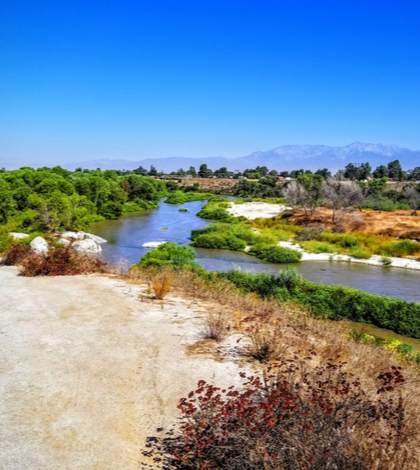Two decades in the making, the conservation plan will protect several endangered species in the 4,800-acre territory in San Bernardino County while maximizing the land’s natural resources, according to its proponents.
After 20 years of back and forth among governmental agencies and the private sector, the Santa Ana River Habitat Conservation Plan has been approved.
The plan, a complex collaboration of water, mining, private and governmental interests, began in the early 2000s, when the U.S. Fish & Wildlife Service, part of the Department of Interior, declared several species in the Upper Santa Ana River Wash Basin to be endangered.
Those species included the kangaroo rat and several plants.
What followed was a decade of negotiations that eventually produced the equivalent of a city’s general plan for the 4,800-acre preserve, located in the east valley section of San Bernardino County not far from Yucaipa.
The preserve includes parts of Redlands and Highland and much unincorporated territory, said Daniel Cozad, general manager of the San Bernardino Valley Water Conservation District.
“It’s about establishing the right use for every piece of land,” Cozad said of the conservation plan, which ultimately had to be approved by the highest reaches of the U.S. government to become reality. “It’s the same as a general plan, because it says ‘this use should happen here and that use should happen there.’ The result is that the endangered species are protected.”
Early last month, the water conservation district’s board of directors unanimously adopted the plan. All that’s left to get now are some minor state permits.
That ended two decades of negotiations that involved Highland and Redlands, the water conservation district, East Valley Water District, San Bernardino Valley Municipal Water District; CEMEX, Robertson’s Ready Mix, Fish and Wildlife, Bureau of Land Management, California Department of Fish and Game, the Inland Valley Development Agency and the Endangered Habitats League.
For so many entities to reach an agreement – even if it took them 20 years to do so – is a significant achievement, board president Richard Corneille said.
“It is rare for a group of seemingly opposing views to commit to such a long process of collaboration,” Corneille said in a statement. “I think this accomplishment reflects our region’s unique spirit of pulling together and doing what’s right for the greater good.”
The habitat conservation plan, which U.S. Fish & Wildlife also approved last month, establishes a preserve in the river wash that covers more than 1,500 acres. That preserve is to be maintained in perpetuity, but the water conservation district has 30 years to implement the plan.
The plan also allows for the capture and storage of water from rivers and streams within the preserve.
In the winter, the conservation district takes surface water from the Santa Ana River and Mill Creek and injects it into the ground, a process known as groundwater recharging. Nearby cities use that to supplement their drinking water supplies.
“Everyone in the Inland Empire relies on groundwater,” Cozad said. “We can recharge up to 70,000 acre feet of water in a good year.”
Also, the plan designates parts of the preserve for sand and gravel mining, an activity undertaken mostly by CMEX and Robertson’s Ready Mix, both local cement companies.
“People have been mining [sand and gravel] out there for years,” Cozad said.
Finally, the conservation plan creates hiking trails within the wash basin that will promote environmental education.
Officials with Fish & Wildlife’s Palm Springs’ office did not return a call seeking comment. However, Paul Souza, regional director of the agency, in a statement called the conservation plan “incredibly important” that accomplishes much for San Bernardino County.
“The wash plan is unique for its complexity and scope, [and] in successfully balancing conservation of species and their habitats with improving water security for local communities,” Souza said. “[It also expands] aggregate mining and offering enhanced recreation opportunities.”
The last piece of the conservation plan puzzle fell into place one year ago, when the Santa Ana River Wash Plan Land Exchange Act became law. Sponsored by Rep. Peter Aguilar, D-San Bernardino, and Rep. Paul Cook, R-Apple Valley, that bill was consolidated into a larger natural resources bill that included more than 100 other pieces of legislation.
Aguilar and Cook’s bill made possible a swap of about 300 acres within the reserve between the U.S. Bureau of Land Management, which is part of the U.S. Department of the Interior, and the conservation district.
The Santa Ana River Wash Plan Land Exchange Act was passed by Congress and signed by President Trump last summer.
Most San Bernardino County residents may never have heard of the Santa Ana River Wash or the plans to preserve it and make full use of its resources, but it’s important to the region, and not just because of environmental issues or its natural resources.
During the next 30 years, the river wash is expected to pump an estimated $700 million into San Bernardino’s economy, mostly through road and other infrastructure construction, groundwater recharging, land dedication, and mining.
“That wouldn’t be possible without the federal government approving the conservation plan,” Cozad said.
When Congress passed the Aguilar-Cook bill last year and President Trump signed it, 20 years of complicated and sometimes difficult negotiations ended.
“I knew that the plan would eventually be put in place,” Cozad said. “Fish & Wildlife is committed to a lot of projects, but we did a pretty good job of reminding them about the plans and what we were trying to do. It’s a good plan, and I knew that it was the kind of plan that eventually gets approved.”
 IE Business Daily Business news for the Inland Empire.
IE Business Daily Business news for the Inland Empire.


